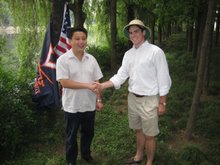 Today we were befriended by a Chinese student from Canton who ended up coming to dinner with us. We had been at the Shanghai Museum and then strolled down Nanjing Road to "the Bund", the Shanghai's financial district during colonial times.
Today we were befriended by a Chinese student from Canton who ended up coming to dinner with us. We had been at the Shanghai Museum and then strolled down Nanjing Road to "the Bund", the Shanghai's financial district during colonial times.Our friend offered to order for us and we ended up with a rather interesting meal. The first dish was roasted squid, followed by a light turnip and jellyfish salad. The waiter then brought out a massive bowl of congealed-blood soup, perhaps more accurately described as blood-jelly soup. As we introduced our Chinese friend to the art of making Yo Mamma jokes, we received dishes of entire salted fish and chicken feet. Being a little less than enthusiastic about filling up on this fare, we were fortunate that pigs fit (heavy on the feet part) emerged next from the kitchen. And of course, we concluded with watermelon.
The waiter cheated us slightly by approaching us while our fluent Chinese friend was away and asking us what kind of tea we preferred. We then ended up with apparently the most expensive tea at 49 rmb, though this is really only about $7.
The museum was very interesting, notably containing exhibits in jade, ancient bronze, all dynasties of painting, and wooden furniture. I decided to focus on just a couple of exhibits and quite enjoyed the Ming Dynasty paintings. The landscapes are remarkably aesthetic. However, I was disappointed with their use of perspective when it came to drawing in people and structures. Hopefully you can make out an example from the posted photo.
Rocks seem to be very important to the Chinese. For example, they like to feature special rocks in gardens. If anyone has any ideas about this, let me know. They are also dominant in these paintings.

5 comments:
Rocks, in zen gardens, symbolize Earth. In China, Rocks tend to symbolize mountains, because gardens are supposed to be smaller examples of the world at large.
You need to be careful about befriending people. Often times these people are hired by restaurants and tea houses to befriend foreigners and then lure them into establishments. But you know what you're doing, anyway (besides the tea).
You'll notice that perspective and people aren't what is important in Chinese art. The magnificence of the landscape always takes precedence, even until the last days of the Qing Dynasty. The vastness of nature goes hand in hand with the rocks in the garden--everything is a symbol of a powerful and grandiose Earth.
Are those docksiders I see? You realize, if a chinaman were to recognize the distinctly wavy tracks, he is bound to say 'Aha! An American has been here!'
Well, of course they're docksiders. The Chinese men seem to have a limited taste for shoes. It seems everyone sports the same loafer-style leather slip-on shoes, going along with dark slacks and a loosely collared short sleeve shirt.
Fortunately, I have hired a man to walk behind me covering my tracks. He uses a bamboo pole with leaves lashed firmly to the end, so I don't really have to worry about being found out.
I really have no pity about your cuisine choices. Have you yet tried fermented tofu (at every meal for two days), pickled radishes, or mushrooms in at least five different shapes (one of which is largely indistinguishible from earthworms), with no meat in sight? Doubt it.
Fraser: how bout a few pics of those dishes for the hard-core foodies out here. Have you tried the xio long bao and drunken crabs yet? Get thee to a Uigar restarant!
Post a Comment